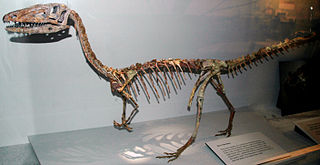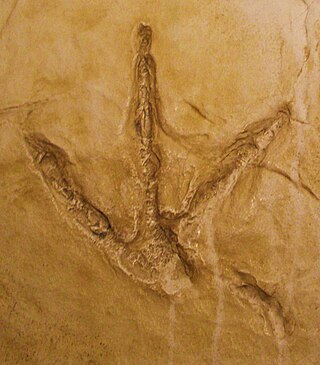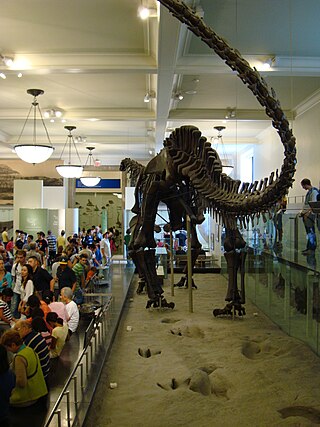
Charadriiformes is a diverse order of small to medium-large birds. It includes about 390 species and has members in all parts of the world. Most charadriiform birds live near water and eat invertebrates or other small animals; however, some are pelagic (seabirds), others frequent deserts, and a few are found in dense forest. Members of this group can also collectively be referred to as shorebirds.

Theropoda, whose members are known as theropods, is a dinosaur clade that is characterized by hollow bones and three toes and claws on each limb. Theropods are generally classed as a group of saurischian dinosaurs. They were ancestrally carnivorous, although a number of theropod groups evolved to become herbivores and omnivores. Theropods first appeared during the Carnian age of the late Triassic period 231.4 million years ago (Ma) and included the majority of large terrestrial carnivores from the Early Jurassic until at least the close of the Cretaceous, about 66 Ma. In the Jurassic, birds evolved from small specialized coelurosaurian theropods, and are today represented by about 10,500 living species.

Palaeognathae is an infraclass of birds, called paleognaths or palaeognaths, within the class Aves of the clade Archosauria. It is one of the two extant infraclasses of birds, the other being Neognathae, both of which form Neornithes. Palaeognathae contains five extant branches of flightless lineages, termed ratites, and one flying lineage, the Neotropic tinamous. There are 47 species of tinamous, five of kiwis (Apteryx), three of cassowaries (Casuarius), one of emus (Dromaius), two of rheas (Rhea) and two of ostriches (Struthio). Recent research has indicated that paleognaths are monophyletic but the traditional taxonomic split between flightless and flighted forms is incorrect; tinamous are within the ratite radiation, meaning flightlessness arose independently multiple times via parallel evolution.

The evolution of birds began in the Jurassic Period, with the earliest birds derived from a clade of theropod dinosaurs named Paraves. Birds are categorized as a biological class, Aves. For more than a century, the small theropod dinosaur Archaeopteryx lithographica from the Late Jurassic period was considered to have been the earliest bird. Modern phylogenies place birds in the dinosaur clade Theropoda. According to the current consensus, Aves and a sister group, the order Crocodilia, together are the sole living members of an unranked reptile clade, the Archosauria. Four distinct lineages of bird survived the Cretaceous–Paleogene extinction event 66 million years ago, giving rise to ostriches and relatives (Palaeognathae), waterfowl (Anseriformes), ground-living fowl (Galliformes), and "modern birds" (Neoaves).

Jeholornis is a genus of avialans that lived between approximately 122 and 120 million years ago during the early Cretaceous Period in China. Fossil Jeholornis were first discovered in the Jiufotang Formation in Hebei Province, China and additional specimens have been found in the older Yixian Formation.

Eubrontes is the name of fossilised dinosaur footprints dating from the Late Triassic and Early Jurassic. They have been identified from France, Poland, Slovakia, Czech Republic, Italy, Spain, Sweden, Australia (Queensland), US, India, China and Brazil (South).

John Alan Feduccia is a paleornithologist specializing in the origins and phylogeny of birds. He is S. K. Heninger Distinguished Professor Emeritus at the University of North Carolina. Feduccia's authored works include three major books, The Age of Birds, The Origin and Evolution of Birds, Riddle of the Feathered Dragons, and many peer-reviewed papers in ornithological and biological journals.

Paraves are a widespread group of theropod dinosaurs that originated in the Middle Jurassic period. In addition to the extinct dromaeosaurids, troodontids, anchiornithids, and possibly the scansoriopterygids, the group also contains the avialans, which include diverse extinct taxa as well as the over 10,000 species of living birds. Basal members of Paraves are well known for the possession of an enlarged claw on the second digit of the foot, which was held off the ground when walking in some species. A number of differing scientific interpretations of the relationships between paravian taxa exist. New fossil discoveries and analyses make the classification of Paraves an active subject of research.

Yixianornis is a bird genus from the early Cretaceous period. Its remains have been found in the Jiufotang Formation at Chaoyang dated to the early Aptian age, around 120 million years ago. Only one species, Yixianornis grabaui, is known at present. The specific name, grabaui, is named after American paleontologist Amadeus William Grabau, who surveyed China in the early 20th century.
Paleontology or palaeontology is the study of prehistoric life forms on Earth through the examination of plant and animal fossils. This includes the study of body fossils, tracks (ichnites), burrows, cast-off parts, fossilised feces (coprolites), palynomorphs and chemical residues. Because humans have encountered fossils for millennia, paleontology has a long history both before and after becoming formalized as a science. This article records significant discoveries and events related to paleontology that occurred or were published in the year 1998.
Paleontology or palaeontology is the study of prehistoric life forms on Earth through the examination of plant and animal fossils. This includes the study of body fossils, tracks (ichnites), burrows, cast-off parts, fossilised feces (coprolites), palynomorphs and chemical residues. Because humans have encountered fossils for millennia, paleontology has a long history both before and after becoming formalized as a science. This article records significant discoveries and events related to paleontology that occurred or were published in the year 1980.

Avisauridae is a family of extinct enantiornithine dinosaurs from the Cretaceous period, distinguished by several features of their ankle bones. Depending on the definition used, Avisauridae is either a broad and widespread group of advanced enantiornithines, or a small family within that group, restricted to species from the Late Cretaceous of North and South America.
Eremopezus is a prehistoric bird genus, possibly a palaeognath. It is known only from the fossil remains of a single species, the huge and presumably flightless Eremopezus eocaenus. This was found in Upper Eocene Jebel Qatrani Formation deposits around the Qasr el Sagha escarpment, north of the Birket Qarun lake near Faiyum in Egypt. The rocks its fossils occur in were deposited in the Priabonian, with the oldest dating back to about 36 million years ago (Ma) and the youngest not less than about 33 Ma.

Saurexallopus is an ichnogenus of four-toed theropod footprints from the Late Cretaceous period. The type ichnospecies is S. lovei, named and described in 1996 from the Harebell Formation. The taxon was originally named Exallopus, but later renamed as Saurexallopus as the former was preoccupied by a polychaete. A second species, S.zerbsti, was named and described in 2004 from the Lance Formation. In 2012 a four-toed track from the Cantwell Formation was referred to Saurexallopus indet. It was also suggested that Saurexallopus was produced by a therizinosaur taxon. In 2013 based on skeletal proportions it was suggested that the ichnotaxon was instead produced by an oviraptorosaur taxon. In 2014 a third species was named, S.cordata, from the Wapiti Formation. In 2018 several tracks from the Blackhawk Formation were referred to Saurexallopus indet.

The 20th century in ichnology refers to advances made between the years 1900 and 1999 in the scientific study of trace fossils, the preserved record of the behavior and physiological processes of ancient life forms, especially fossil footprints. Significant fossil trackway discoveries began almost immediately after the start of the 20th century with the 1900 discovery at Ipolytarnoc, Hungary of a wide variety of bird and mammal footprints left behind during the early Miocene. Not long after, fossil Iguanodon footprints were discovered in Sussex, England, a discovery that probably served as the inspiration for Sir Arthur Conan Doyle's The Lost World.
Incognitoolithus is an oogenus of medioolithid fossil bird egg. It is notable for bearing evidence of predation, possibly from a bird pecking the eggshell.
Plagioolithus is an oogenus of fossil egg. It is from the Early Cretaceous of Japan. It was probably laid by a bird, making it the oldest known fossil bird egg.
The year 2017 in archosaur paleontology was eventful. Archosaurs include the only living dinosaur group — birds — and the reptile crocodilians, plus all extinct dinosaurs, extinct crocodilian relatives, and pterosaurs. Archosaur palaeontology is the scientific study of those animals, especially as they existed before the Holocene Epoch began about 11,700 years ago. The year 2017 in paleontology included various significant developments regarding archosaurs.

Bellatoripes is an ichnogenus of footprint produced by a large theropod dinosaur so far known only from the Late Cretaceous of Alberta and British Columbia in Canada. The tracks are large and three-toed, and based on their size are believed to have been made by tyrannosaurids, such as Albertosaurus and Daspletosaurus. Fossils of Bellatoripes are notable for preserving trackways of multiple individual tyrannosaurids all travelling in the same direction at similar speeds, suggesting the prints may have been made by a group, or pack, of tyrannosaurids moving together. Such inferences of behaviour cannot be made with fossil bones alone, so the record of Bellatoripes tracks together is important for understanding how large predatory theropods such as tyrannosaurids may have lived.
Wakinyantanka is an ichnogenus of footprint produced by a large theropod dinosaur from the Late Cretaceous Hell Creek Formation of South Dakota. Wakinyantanka tracks are large with three long, slender toes with occasional impressions of a short hallux and narrow metatarsals. Wakinyantanka was the first dinosaur track to be discovered in the Hell Creek Formation, which remain rare in the preservational conditions of the rocks. The potential trackmakers may be a large oviraptorosaur or a small tyrannosaurid.

















